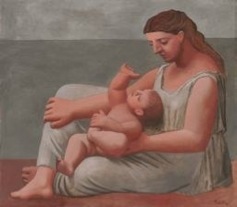Mother and Child Research
2010
It is often said that the bond between a mother and her newborn child is one of the strongest relationships that can exist. Pablo Picasso, a well-known artist all over the world, shows this bond in his series of 1920s paintings entitled “Mother and Child.” In this specific painting, “Mother and Child by the Seashore” created in 1921, a mother is seen sitting on the ground with her infant in her lap. The infant reaches up towards her face as the two look at each other with loving expressions with the seemingly endless ocean in the background.
However, when attempting to look more closely, the painting seems to depict different kinds of emotions. The mother’s hand, for example, does not seem to be holding the baby in a careful, embracing way. Only one hand is on the infant’s
The Joys of Parenting
back and does not appear to be “holding” him, but rather resting there as a way to simply keep the infant from falling over. The mother’s other hand seems to be clutching her leg, almost as if she is timid or nervous and is holding her own leg in order to calm herself. The mother’s body language also seems to show timidness by her slight pulling back from the child as he reaches for her face.
These actions suggest much more than the loving expression on her face. I believe that this is to show the timidness a new mother can feel when taking care of her newborn son. Having a child for the first time can be an emotional and stressful time, and Picasso’s painting shows this through the combination of her loving expression and nervous body language. However, the infant is reaching towards her and looking up back at her, clearly seeing the woman holding him is his mother and longing to be closer to her, both physically and emotionally. Picasso’s painting is a beautiful depiction of first time parenting and the emotions that flood through a mother and child as they begin to develop a close relationship.
Precis:
1.
Penrose, Roland. “Beauty Must Be Convulsive.” Picasso: His Life and Work. Third Edition ed. Berkeley and Los Angeles, California: University of California Press, 1981. 240-241. Print.
This book, which details various accounts of Pablo Picasso’s life and paintings, includes a section in which Penrose argues that Picasso’s own son was born soon before the time this painting was created and because of this reason, the image of his wife Olga and infant son become the subject of numerous Mother and Child paintings. Penrose gives a detailed account of some of the biographical information about Picasso’s life around that time period that is relevant to thematic elements of the Mother and Child paintings. Penrose includes these biographical occurrences in order to explain Picasso’s feeling and emotions surrounding the creation of this painting. It is a clear explanation for curious fans of art, Picasso, or history all over the world.
2.
“Pablo Picasso Biography .” Spain Travel Guide – The Definitive Guide to Travel in Spain. N.p., n.d. Web. 11 Jan. 2010. <http://www.spanish-fiestas.com/art/spanish-artists-picasso.htm>.
This article argues that Picasso reflected his own life experiences in his work. By describing specific occurrences around the same time period that Picasso created Mother and Child, the article successfully explains the reason for the surrealistic images in not only Mother and Child, but other works by Picasso around the same time period as well. These explanations are given in order to help people further understand the emotions and reasons behind the creation of this painting. The article successfully communicates its knowledge of Picasso’s Mother and Child to critics and fans as well as those simply interested in the painting.
3.
“Pablo Picasso (Spanish artist): Surrealism- Britannica Online Encyclopedia.” Encyclopedia- Britannica Online Encyclopedia. N.p., n.d. Web. 11 Jan. 2010. <http://www.britannica.com/EBchecked/topic/459275/Pablo-Picasso/59635/Surrealism>.
This article claims that Picasso painted various paintings in the artistic category of surrealism throughout the 1920s, the period when he painted Mother and Child. It describes the method of surrealism and how it can be seen in Picasso’s paintings. The article argues surrealism can be easily seen in Picasso’s 1920s paintings in order to further explain Picasso’s motives for painting Mother and Child with loving, sentimental emotions. An artistically inspired audience can truly enjoy Picasso’s methods as described by this article.
“Mother and Child” by Pablo Picasso, 1921

